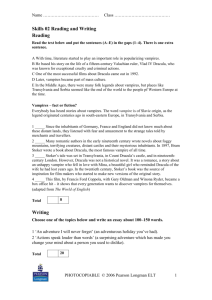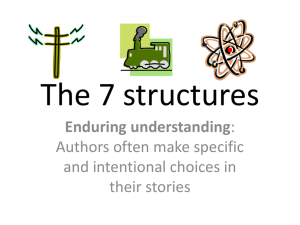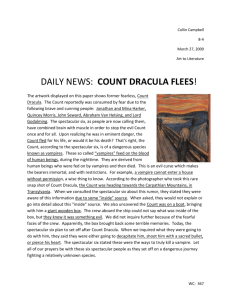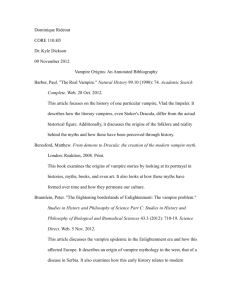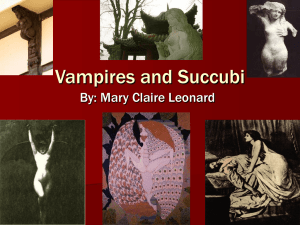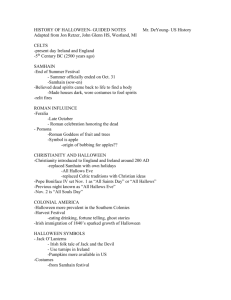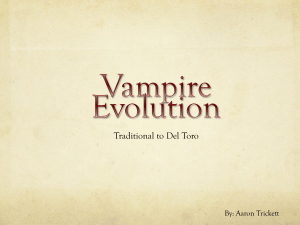The Heart of a Vampire
advertisement
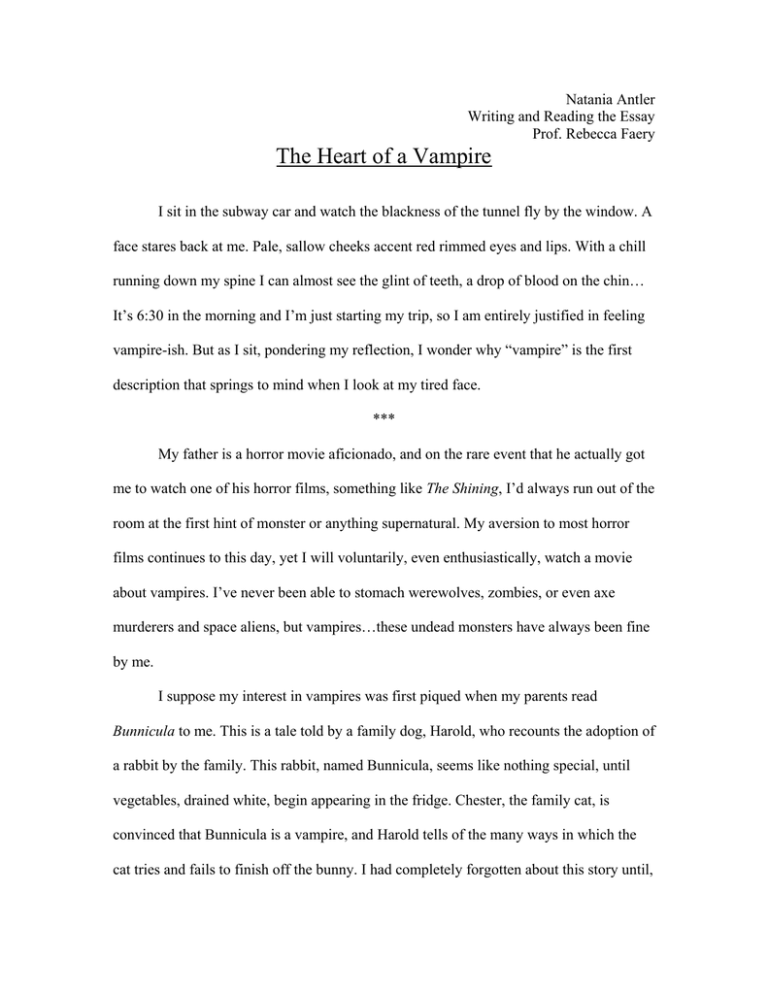
Natania Antler Writing and Reading the Essay Prof. Rebecca Faery The Heart of a Vampire I sit in the subway car and watch the blackness of the tunnel fly by the window. A face stares back at me. Pale, sallow cheeks accent red rimmed eyes and lips. With a chill running down my spine I can almost see the glint of teeth, a drop of blood on the chin… It’s 6:30 in the morning and I’m just starting my trip, so I am entirely justified in feeling vampire-ish. But as I sit, pondering my reflection, I wonder why “vampire” is the first description that springs to mind when I look at my tired face. *** My father is a horror movie aficionado, and on the rare event that he actually got me to watch one of his horror films, something like The Shining, I’d always run out of the room at the first hint of monster or anything supernatural. My aversion to most horror films continues to this day, yet I will voluntarily, even enthusiastically, watch a movie about vampires. I’ve never been able to stomach werewolves, zombies, or even axe murderers and space aliens, but vampires…these undead monsters have always been fine by me. I suppose my interest in vampires was first piqued when my parents read Bunnicula to me. This is a tale told by a family dog, Harold, who recounts the adoption of a rabbit by the family. This rabbit, named Bunnicula, seems like nothing special, until vegetables, drained white, begin appearing in the fridge. Chester, the family cat, is convinced that Bunnicula is a vampire, and Harold tells of the many ways in which the cat tries and fails to finish off the bunny. I had completely forgotten about this story until, while looking further into the topic of vampires, I stumbled upon a description of vampire watermelons. According to an article in Wikipedia, it was a superstition held by the Roma people that a watermelon kept past ten days would sometimes turn into a vampire, complete with the appearance of blood on its skin. They weren’t known to do much harm, lacking teeth, but were said to roll around growling. Most vampires, however, are not rolling fruit or rabbits. They are usually men or women who drink the blood of unsuspecting folk; the effects of this blood draining range from serious injury, to death, to becoming a vampire oneself. The tales of vampires closest to our current definition originated in Eastern Europe, but vampires have popped up all over the world in myths dating back as far as Babylonia. As time passes vampires evolve and change with the societies that recount their existence. Vampires as we know them now were popularized in Western consciousness most notably by Bram Stoker’s novel, Dracula, published in 1897. Stoker loosely based his character on a historical Count Dracula, Vlad (the Impaler) Tepes, who was a particularly brutal and bloodthirsty prince from Wallachia (now in Romania) in the 1400s. But this is where it gets interesting: in the novel, the historical Dracula, a brutal Turk-fighting national hero, is switched to a cultured Transylvanian nobleman who likes to drink blood. As the real Vlad is changed for Stoker’s novel, so vampires have evolved in nature since their conception. Folkloric vampires were often the angry or cursed spirits of deceased peasants come back to prey on the living, usually their own family. Modern vampires, on the other hand, are much more complicated. While they can roam freely from their homelands, they also have a number of rules governing their behavior. It is unclear how these vampires become vampires, because it changes from story to story, but many were human once. The important thing about modern vampires is that they’ve stepped out of folklore to a place in society anchored in literature and other such permanent media. This hasn’t homogenized vampires; in fact, it has had the opposite consequence: vampires are now more diverse and widespread than ever. Our Western culture, me included, seems to have become captivated, if not obsessed, by vampires, judging from the amount of entertainment featuring these bloodsucking creatures. Are vampires nothing special as monsters are concerned because as humans we like to create beings that embody our current fears, or is there something else about vampires that makes them so popular? I’d posit that they are indeed unique monsters. As a society, even as we fear vampires, we are also strangely attracted to them. We like vampires in spite of ourselves. We portray vampires as beautiful, smart and powerful creatures, even though their definition—the thing that unites all variations on the vampire myth—is that they drink blood, which is ultimately harming some victim. Vampires, especially when they are portrayed as sentient beings and not mindless hordes, should be the very definition of evil, yet we can’t get enough of them! I like vampires in part because they have always seemed intelligent to me. Unlike werewolves, vampires must often use cunning and charm to get at their prey, rather than brute force. How else would they be invited into a dwelling? While this invitation requirement may be relatively new to vampire lore, older legends suggest that vampires had an obsession with counting, almost to the point of obsessive compulsion. According to Wikipedia, seeds were left by the graves of suspected vampires in Eastern Europe to keep them occupied with counting through the night, and in China bags of rice were also supposed to stop vampires in their tracks. While this trait of vampires has largely died out in modern lore, we still have Sesame Street’s Count von Count! Isn’t obsessive compulsive behavior and affinity for numbers often associated with intelligence? Vampires are in fact scarily similar to your stereotypical college nerd. Smart, thin and pale, only coming out at night….here the similarities end, and I dart my eyes around the room, before admitting that I brought my vampire cloak with me to college in the hopes of wearing it for Halloween. I’d like to say that I’m attracted to vampires only because they’re smart, but to be honest I’d have to admit that some of them are also rather handsome. Even though vampires were not supposed to be notably attractive in the Eastern European tradition, they looked well-fed, and were often dark-skinned, certainly in contrast to their malnourished prey. Ever since The Vampyre, a short novel published in 1819 by John William Polidori, contained as its protagonist Lord Ruthven, a philandering, undead, and attractive aristocrat, we’ve seen sexually irresistible and wealthy vampires throughout modern fiction. While Dracula isn’t described in Stoker’s novel as particularly beautiful, he is certainly striking, and has a penchant for preying on young and beautiful women. Mina Harker, another female character in the Dracula novel, is discovered being given a “baptism in blood” from Dracula himself: With his left hand he held both Mrs Harker’s hands, keeping them away with her arms at full tension; his right hand gripped her by the back of the neck, forcing her face down on his bosom. Her white nightdress was smeared with blood, and a thin stream trickled down the man’s bare breast, which was shown by his torn open dress. When I first read this passage a few years ago I thought it sounded more than a bit kinky, and all that I’ve read since then confirms this notion. In fact, Dracula has at its heart a clear commentary on gender roles and sexuality. Here’s a passage towards the beginning of the book in which Jonathan Harker meets “the weird sisters,” Dracula’s kin: “All three had brilliant white teeth, that shone like pearls against the ruby of their voluptuous lips. There was something about them that made me uneasy, some longing and at the same time some deadly fear.” As one sister is about to bite Harker says, “I closed my eyes in a languorous ecstasy and waited—waited with beating heart.” Carol Senf, in her book Dracula: A Reader’s Companion, says that Stoker is making a commentary on the new women in Victorian society. He feels threatened by sexually forward women (although not necessarily smart and technically capable women like the heroine Mina), thus has turned them into vampires. Dracula symbolizes foreign sexuality, something threatening in the Victorian era, and has often been interpreted to be homosexual. I’m not sure about that last interpretation, but I do think that Senf has a point when she says this about the end of the 19th century when Dracula was written: “During a period so concerned with the connection between sexuality and crime, it would have been easy to associate almost any kind of sexuality with the monstrous Other, the vampire.” Perhaps the unnatural beauty and sex appeal of vampires have at their roots something to do with religion. After all, in Slavic folklore a person could become a vampire after being excommunicated or buried improperly. In fact, much of the development of the vampire legend was influenced by the schism between the Orthodox and Roman churches in Eastern Europe. In the Orthodox tradition, an uncorrupted body was a vampire; in the Roman tradition, it was a saint. Religious undertones persist in vampire fiction to this day, most notably in that vampires can be warded off by various holy objects. A handsome or beautiful vampire is now synonymous with an evil tempter or temptress. But perhaps as the dominance of religion, or at least “morality” in the Victorian sense, has subsided a bit recently in our culture, so it has in vampire stories. We’ve become more open to admitting that we think vampires can be sexy and sympathetic, just as we’re more open to displaying our own sexuality. In her essay on the sexual aspects of the treatment of vampires in fiction, Margaret Carter paraphrases Carol Senf, who, “has pointed out that the very qualities that make the traditional vampire a threat in nineteenth-century stories such as Carmilla and Dracula -- particularly his or her erotic power and unconventional behavior -- make the vampire appealing to twentiethcentury readers.” Even Brad Pitt, Tom Cruise and Antonio Banderas combined in the movie Interview with the Vampire might not have convinced me that vampires could be sexy until I read a fantasy book on the subject, which soon became one of my favorites. Sunshine is about a young woman who through a serious of complicated circumstances rescues, befriends, and then even starts to fall in love with a vampire. This vampire, to his credit, stops preying on humans for the most part—and this may help with his potential for attractiveness—but still he remains a vampire. Had I not read this book, I probably would have continued blissfully watching vampire movies without a second thought as to why I like them, but now the reason has been made painfully clear. The good qualities of vampires are not immediately obvious, but once you start looking for them they pop up everywhere. I think that Nina Auerbach, in the introduction to her book, Our Vampires, Ourselves puts it well when she says this, To the jaded eye, all vampires seem alike, but they are wonderful in their versatility. Some come to life in moonlight, others are killed by the sun; some pierce with their eyes, others with fangs; some are reactionary, others are rebels; but all are disturbingly close to the mortals they prey on. As a society we’re in a rocky romance with vampires. We create and destroy rules for their behavior, often we fall in love with them, sometimes we scorn them, killing them off in droves, but always we remain captivated. Vampires certainly embody our fears, but above all our secret desires and our dark sides. Next Halloween, as I don a luxurious black velvet cloak with red satin lining, a skimpy black tank top and pants, and some abnormally sharp teeth, I will be glad, but perhaps still slightly disappointed, that the chill in the autumn air is a completely natural occurrence and not emanating from my pale outstretched hand. Note: The texts cited and used in the preparation of this essay include Nina Auerbach’s Our Vampires Ourselves, University of Chicago Press, 1995; Margaret L. Carter’s Lust, Love, and the Literary Vampire online in Strange Horizons, 2002, at http://www.strangehorizons.com/2002/20020722/vampire.shtml; Bram Stoker’s Dracula, Oxford Univeristy Press, with introduction by Maud Ellmann, 1996; Carol Senf’s Dracula: A Reader’s Companion, Twayne Publishers, 1998; and articles from Wikipedia Online, “Dracula,” “Vampire,” “Vampire Fiction,” Vampire Melons.”
